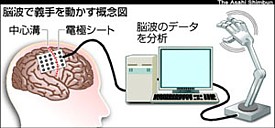 Researchers at Osaka University are stepping up efforts to develop robotic body parts controlled by thought, by placing electrode sheets directly on the surface of the brain. Led by Osaka University Medical School neurosurgery professor Toshiki Yoshimine, the research marks Japan's first foray into invasive (i.e. requiring open-skull surgery) brain-machine interface research on human test subjects. The aim of the research is to develop real-time mind-controlled robotic limbs for the disabled, according to an announcement made at an April 16 symposium in Aichi prefecture.
Researchers at Osaka University are stepping up efforts to develop robotic body parts controlled by thought, by placing electrode sheets directly on the surface of the brain. Led by Osaka University Medical School neurosurgery professor Toshiki Yoshimine, the research marks Japan's first foray into invasive (i.e. requiring open-skull surgery) brain-machine interface research on human test subjects. The aim of the research is to develop real-time mind-controlled robotic limbs for the disabled, according to an announcement made at an April 16 symposium in Aichi prefecture.
Although brain waves can be measured from outside the scalp, a stronger, more accurate signal can be obtained by placing sensors directly on the brain -- but that requires open-skull surgery, making it more difficult to recruit volunteer test subjects.
The researchers, who have filed a license application with the Osaka University Hospital ethics board, are working to enlist willing subjects already scheduled to have brain electrodes implanted for the purpose of monitoring epilepsy or other conditions. The procedure, which does not involve puncturing the cortex, places an electrode sheet at the central sulcus, a fold across the center of the brain near the primary motor cortex (which is responsible for planning and executing movements).
To date, the researchers have worked with four test subjects to record brain wave activity generated as they move their arms, elbows and fingers. Working with Advanced Telecommunications Research Institute International (ATR), the researchers have developed a method for analyzing the brain waves to determine the subject's intended activity to an accuracy of greater than 80%. The next step is to use the data to control robot arms developed by the University of Tokyo's Department of Precision Engineering.
[Source: Asahi]

nawcom
The article is about Japan placing electrodes directly onto the brain to pick up more accurate signals. This actually has no direct link to having computer controlled body parts; as the FTA says they have been using electrodes placed directly on the brain to pick up activity when one moves his or her arm.
Why is this old news? during my last round of epilepsy correction surgery, (in 2001) I went through surgery so they could place an electrode plate inside my skull in order to pick up right temporal and frontal lobe activity with the greatest accuracy. I can tell you it gave me the worst headache ever for the week or so they monitored me for seizure activity, but they immediately removed it once they decided the correct tissue to remove. Thankfully since then, it showed that the second time, not third, was the charm, for i'm off of seizure drugs without having seizure activity. And intelligence-wise, well, I still can write in assembly language, and I see too many people who lack basic intelligence every single day of my life. (no pointing at specifics :-P) As you can see, this article is BS. Wake me up when they are using electrodes to directly interface with and manage along with input and alter brain activity, none of this activity reading bullshit.
[]Alexi Husky
First up prosthetic limbs, next up Tails and ear implants.
Heeellllllooooo NEEEKKOOOO ^_^ |/,
[]magetoo
nawcom: Perhaps you should read the entry again. No connection?
"The next step is to use the data to control robot arms developed by the University of Tokyo’s Department of Precision Engineering."
This is just the first step - recording and analyzing data. Which they are going to do on epilepsy patients (and others) who are already going to have their skulls cracked open and electrodes inserted. In other words, yes, they are already performing the procedure you're describing. The controlling of external parts *is* what sets this apart.
[]Mike
I read the article and its amazing, if it is bs or not.
[]Brad
Im interested in using this technology for human augmentation and would gladly volunteer to test it.
[]Jorgen
I'd gladly volunteer for human testing :)
[]